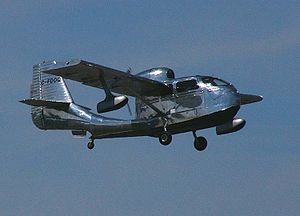Republic RC-3 Seabee
| RC-3 Seabee | |
|---|---|
 |
|
| Role | Amphibious aircraft |
| Manufacturer | Republic Aviation Company |
| Designer | Percival Spencer |
| First flight | December 1, 1945 |
| Introduction | 1946 |
| Produced | 1946–1947 |
| Number built | 1,060 |
| Unit cost |
US$6000 in 1946
|
| Variants | Trident TR-1 Trigull |
The Republic RC-3 Seabee is an all-metal amphibious sports aircraft designed by Percival Spencer and manufactured by the Republic Aircraft Corporation.
The RC-3 Seabee was designed by Percival Hopkins "Spence" Spencer, an aviation pioneer who built his first hang glider in April 1911. At the time, he was 17 years old and constructed it from plans he found in a Popular Mechanics magazine. On May 15, 1914, Spencer made his first powered flight in a Curtiss flying boat. In 1937, he joined Sikorsky engineer Vincent A. Larsen to design their first, and only, amphibious aircraft, the Spencer-Larsen SL-12C. Development of the plane progressed slowly and in September 1940 Spencer left the partnership to form his own company. His resulting design was the Spencer S-12 Air Car Amphibian. Construction of the S-12 began on March 1, 1941 and the small, two-seat S-12 prototype, registered NX29098, made its first flight on August 8, 1941. The S-12 was a fabric covered amphibian with a unique boxlike forward cabin, a high wing with a two-bladed propeller in pusher configuration and a long, slender tail boom.
In December 1941 Spencer put the Air Car into storage and joined the war effort as a test pilot for the Republic Aircraft Corporation. By 1943, he had flight tested 134 of the company's P-47 Thunderbolts.
In April 1943 Spencer left Republic Aircraft to join the Mills Novelty Company of Chicago, Illinois who wanted to use his Air Car to promote their company. Spencer used the company's wood forming equipment to build a new egg-shaped cabin for the Air Car and began demonstrating the aircraft to his former employers, Republic Aircraft. Seeing the potential of the Air Car as the perfect sports plane for pilots returning from the war, Republic purchased the rights to the Air Car in December 1943 and immediately began development of an all-metal version designated the Model RC-1 Thunderbolt Amphibian. On November 30, 1944 the first RC-1 Thunderbolt Amphibian, registered NX41816, made its first flight with Spencer at the controls.
...
Wikipedia
